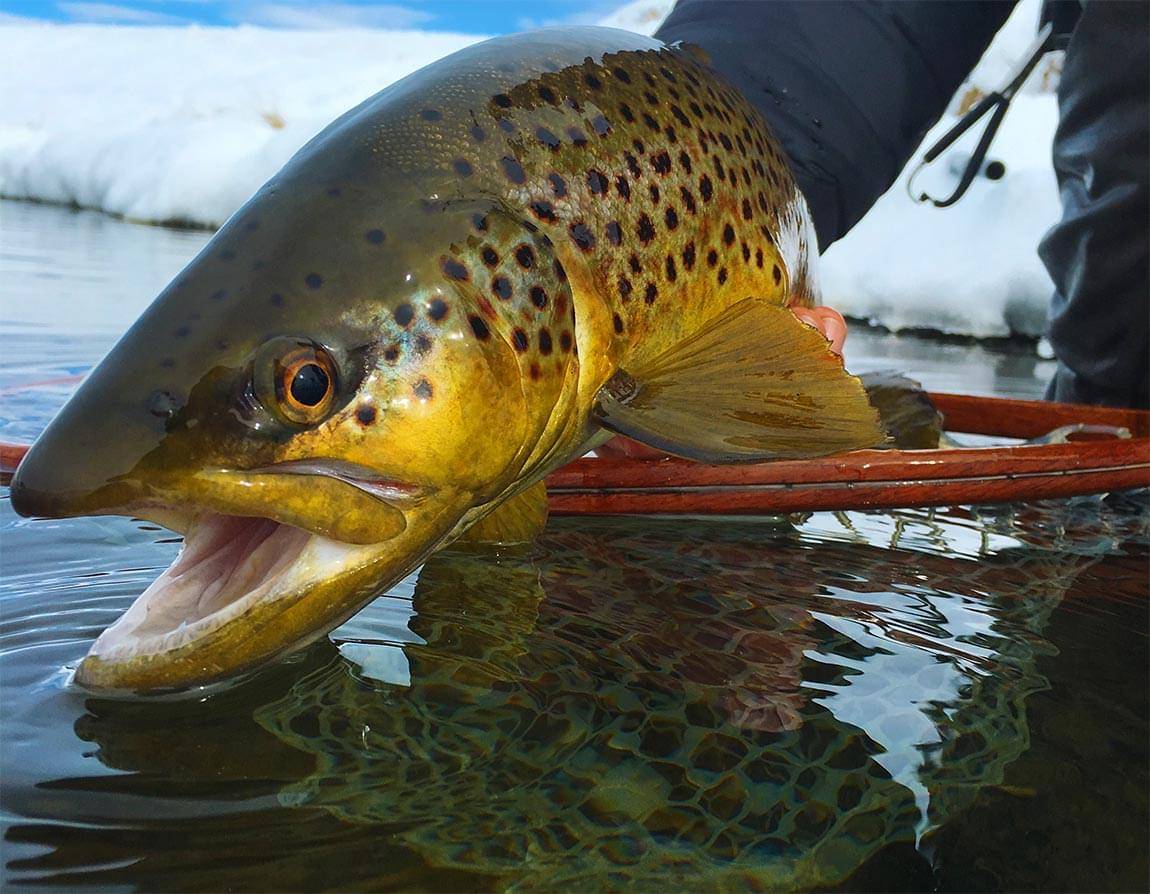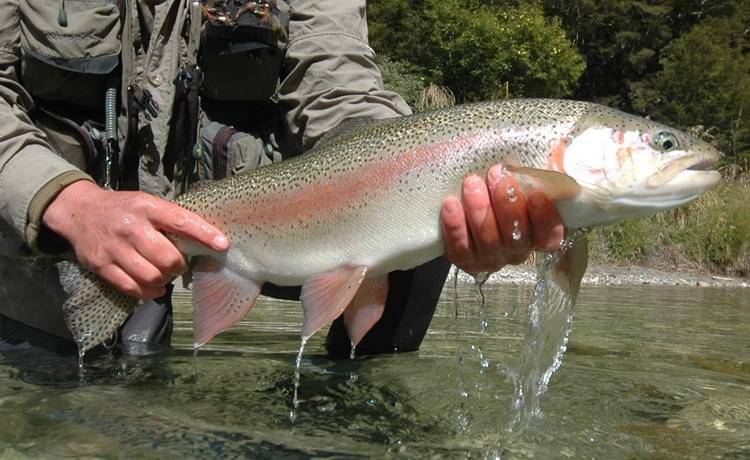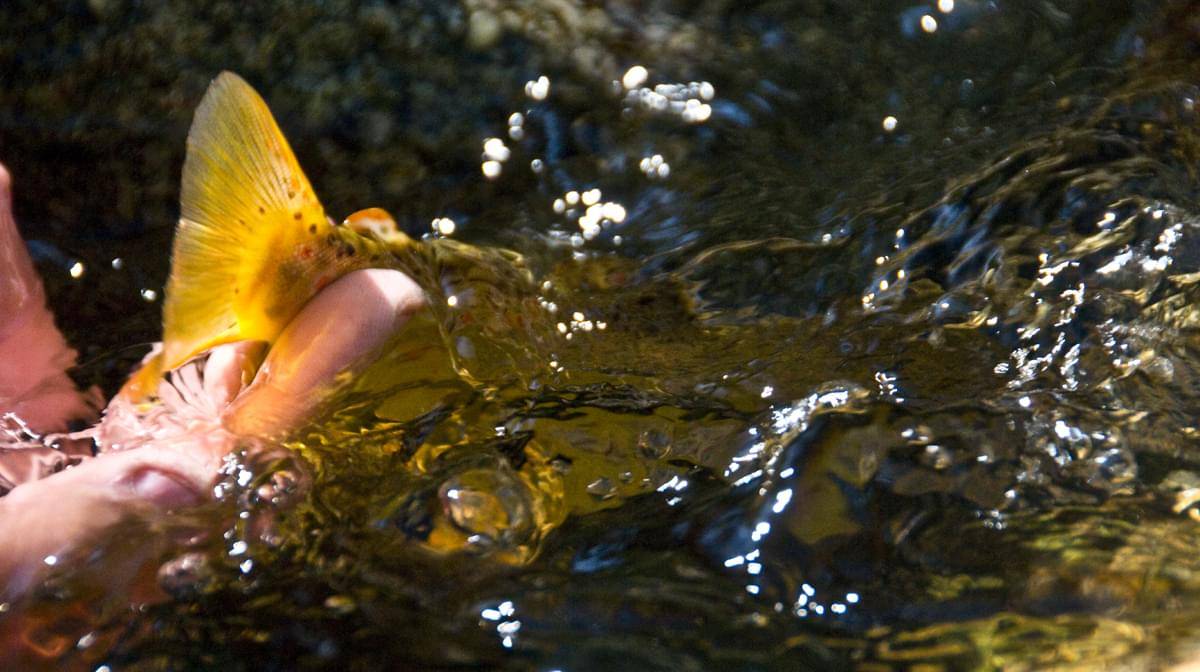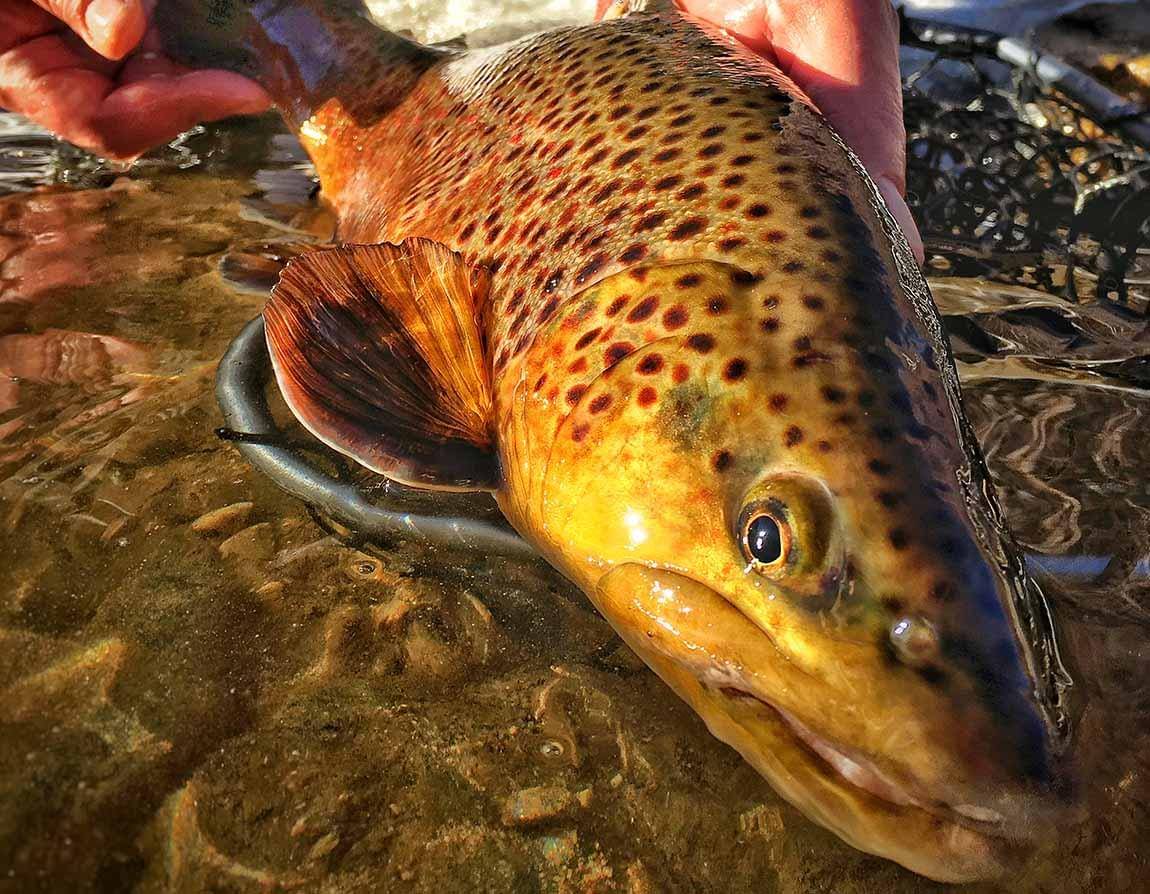Proper Catch and Release
Common Myths and 10 Best Practices to Let Them Go So They Can Grow
Catch and release is a common practice among fly fishermen. However, if not practiced correctly, the mortality rate for fish can be extremely high. This means if you catch and release 50 fish in a day poorly, you’re doing more harm than the angler who is keeping his limit of 3-8 fish for the day (depending on your local regulations). This is alarming for most catch and release fishermen as it is a part of their ethical code to “let them go so they can grow”.
We are going to outline several key aspects to proper catch and release that need to be used every time for releasing trout and other fish caught on the fly.
The Importance of Catch and Release
A Trout Legacy
Catch and release, if done correctly, is an extremely important part of our fly fishing sport. Our rivers across the US are receiving more fishing pressure than ever before and if we want to continue to enjoy fly fishing for trout in good numbers over the generations, we need to catch and release more than we catch and keep. Our population is simply too large to maintain our waters if we all catch and keep.
This gives us an opportunity to leave a legacy behind on how we practice catch and release so our children and children’s children can enjoy the sport as we have. Remember that next time you are on the river and practice these safe catch and release tips.
A Good Video on Proper Catch and Release
The New Zealand Fish and Game Commission has a nice video about catch and release. Watch it and then look over the specific tips below.
Common Myths of Catch and Release
Let’s go over a few quick myths of catch and release so we don’t make the mistake of thinking we did a good job, but likely sent the fish off to his death.
Myth 1 – The Fish Swam Off So He’s Ok
This is a big fat lie. Over 90% of fish mortality happens after the fish swims off. I’ve seen fish released by people upstream only to see the fish belly up 2 hours later downstream on the river bottom, belly up. This is why we need to practice the best technique in catch and release every time, because once we let go of that fish, if we didn’t do our job right, the chances of survival are thin.
Myth 2 – He was only on the rocks for a minute
I know most of you don’t “usually” set the fish on the rocks, but setting the fish out of the water and onto anything is terrible for them and reduces their chances to live substantially every second they are out of the water. Never put the fish on rocks, grass or anything out of the water, even if it was wet. the lack of oxygen and the slime lost drastically reduces the trout’s chance for survival.
Myth 3 – Catch & Release people are a bunch of Elitist Jerks
This is a partial myth. I’m sure there are some jack-waggers out there that use C&R to make themselves seem superior, but they’ve missed the point. The point is doing what we can do to conserve and protect a precious resource that we consume every time we fish. Everyone kills fish, even C&R guys, because trout are delicate. It is our responsibility as those consuming this resource to do what we can to protect and preserve it as well. We use the trout rivers, we need to protect them. This is the reason so many catch and release anglers care and attempt to educate when they see photos or poor handling of fish. Most anglers motives are pure and they want to help preserve the rivers they fish. It goes a long way to know you have C&R guys on your favorite waters instead of guys taking or poorly handling the fish you also love to catch.
Myth 4 – Good C&R is a Religion
We aren’t saying that if you don’t properly catch and release a trout, that you’re a bad person or that we’ll sick PETA on you or that the trout’s feelings are hurt or the trout gods will keep you from catching fish ever again (well that may be true.. verdict is still out on that 🙂 ). The entire point of catch and release is to conserve a wonderful resource that we all enjoy and it’s our job as anglers to be good stewards of what we use and consume. Let them go so they can grow.
Good Preparation Protects the Fish
1 – Watch the Water Temps
Water temps above 68° F produce stress on all trout species and the higher the temps get, bigger chance they have of getting over-exhausted and dying after being released. Avoiding fishing streams in the heat of the day during summer is not only a good strategy as fish are less willing to eat, but it also protects the fish from over-exhaustion and death. I’ve come across “fish-kills” during the dog days of summer and it’s heartbreaking.
2- Fish Barbless Hooks
Pinching your barbs down in the evening as you watch TV or everytime you’re out on the water is a good practice. Barbs increase the size of the puncture in a fish’s mouth and tears more of their skin when they are removed. These wounds don’t heal as well as we hope and can harm the fish’s ability to feed and survive down the road. If you don’t believe me, go fish the Blue river in silverthorne and look at the fish in that river once caught, they look like they have a piercing fetish. Pinching your barbs makes for an easier release and for less overall damage to the trout. It’s best to do it before you get on the water since you’ll likely get lazy or forget once on the water.
Playing the Fish Correctly
Playing the Fish Correctly
3- Good C&R Begins with Playing the Fish Well
The key to proper catch and release is playing the fish quickly and safely. The longer you play a fish, the more lactic acid is built up in their system and the more they struggle to recover. Playing the fish for over 2 minutes, is generally a bad idea. Trout don’t recover as quickly making them susceptible to suffocation or being eaten by other trout or birds of prey. Play the fish quickly by keeping side pressure on the trout to bring it to the net quickly. Side pressure is turning the tip of your rod to the left or right of the fish to turn it’s head back towards you. You’ll be amazed how doing this can bring the fish in quicker and with heavier tippet and leader, you can bring them in quickly (under 2 minutes max) for a safe release.
4- Land Fish Quickly Using Heavier Tippet
Fish don’t care as much as you think when they see the line. Often times you don’t need 5x and 6x or even 7x tippet. You can be just as successful with 2x to 4x. Fishing with heavier leader will allow you to land the fish quicker and keep you from wearing out the fish beyond what it can recover as mentioned above.
The Best Flies for CATCHING & RELEASING
Euro nymphs are barbless, catch fish quickly and with a euro technique, you have minimal line out being able to catch and land fish faster, giving them the best chance to be released without stress or harm. Out of the 100s of trout I’ve spoken with, they all say these are there favorites.
Use coupon code: EURO50
To get $50 Off Any or All of the Assortments Below (Shipping is free too!)
Landing the Fish
Landing The Fish
5- Keep the Fish in the Water and Off Rocks, Banks and Land
Landing the fish is where most things go terribly wrong. Fish have protective slime coating that stays off infection and diseases. Removing this film is the same as drinking 20 beers and then spending the afternoon in a daycare, you’re going to get sick. For trout this makes them drastically more susceptible to whirling disease and other infections and diseases that kill trout days after being released. Placing the fish on the rocks, banks, grass or other places out of the water harms the fish in three ways:
- It removes the protective slime increasing risk of disease or infection
- It can damage the fish beyond recovery. Fish can’t handle damage to the head, gills or gut since they don’t really have much in terms of a skeletal structure. Gravity out of the water is much greater and causes enormous stress on the trouts system.
- Fish can’t breathe out of the water. Every second you keep a fish out of the water can reduce their chance of survival by 10%. 5 seconds is a coin flip on survival.
6- Use a Rubber Landing Net in the Water
While a quick catch and release with wet hands without a net is safe, if the fish is too excited or too large, it can be messy to try to land them without a net. Using a net and keeping the net in the water will provide proper environment to land the fish safely. Use these tips to land the fish safely:
- Use a large rubber landing net – other nets that have knots or string netting can be just as harmful as putting them on the bank.
- Keep the net in the water and the fish relaxed. Think of the net as more of a water gate around the trout, then something you grab it in and support it with. Use the net to contain the fish, not hold it out of the water.
- Use rubber nets and be careful not to get the gills caught our damaged
7- Don’t Squeeze Too Hard
When the fish is out of the water, its entire body compresses on itself. You’re taking a fish from a weightless environment into a heavily weighted environment and it’s hard on the fish regardless. If you have to hold the fish out of the water for a picture, then make sure to not squeeze too hard especially around the vitals. Hold the fish just behind the pectoral fins (a fish’s arms) on the belly softly. With your other hand you can grab the fish right in front the the tail.
Always hold the fish over water in case it falls or squirms it won’t land on rocks, but in the water instead, preferably over a net so you can revive him after.
* Tip – At times fish are hard to hold on to. Grabbing them firmly by the tail acts as a sort of paralyzer to the fish and can calm them down. Don’t over squeeze, but a good firm grip (like gripping a steering wheel) is the right amount to hold the fish in place.
8 – Cut the Line if the Hook is Deep
When it comes time to unhook the fly from the trout, hopefully the barbless fly you have comes out easy. If the fly is too deep, then simply cut the line. I’ve caught fish that have tippet and a fly coming out of their bunghole before, it isn’t as difficult to pass as you’d think and it often comes loose on it’s own (if it’s barbless) later on allowing the fish time to recover easily and keeping it safe. Shoving forceps down it’s throat to get the fly back is trading a fish life for a $2 fly. Just not worth it. If you need flies that bad or are on a tight budget, cut the fly, send me a message and I’ll hook you up with a good deal.
9 – Photograph Fish Selectively, Quickly & Creatively
So you do a good job landing the fish quickly, keep it off the rocks, use a landing net. Then you ruin it all by holding the fish out of the water for 2 minutes as you attempt to get the grossly over-done photo commonly known as the grip and grin. This is rough on two levels. One, every second you keep the fish out of the water decreases it’s chance to survive and two, you look like every other guy holding a fish. Below are some creative photos I’ve found online that are good for the fish and look better than a grip and grin anyway.
Another note to share is you don’t need to photograph every trout you catch. They are all gorgeous so selectively pick a couple each day and grab some creative shots and you’re photo album will look much better than 1000 grip and grins.
The best way to get a photo safely of a fish is to leave it in the net and the net in the water so the fish is just chilling in there with the hook removed. Get your camera ready or your iphone on the timer and set everything up. Once you are ready to hit the shutter button, quickly and gently lift the fish to your desired shot and take pics quickly. Photos look awesome when the water is dripping off the fish vs drying in the sun anyway. This is better for the trout and better for your album. Be quick and gentle and if possible always keep the head and gills underwater or slightly out and only for a moment.
- Low and close up shots really show the spots off on this brown
- Notice the trouts head and gills are underwater adding realism and creativity to the shot (photo courtesy of Gink and Gasoline - http://www.ginkandgasoline.com/
- Notice how the water is dripping off the fish? This fish was quickly and gently removed from the water for a quick, low-angle shot. (photo courtesy of - http://www.ginkandgasoline.com/)
- Sometimes a shot of the tail is a great way to capture "the release"
- This rainbow is fully submerged except for the tail offering a great shot of the strips and coloration of the trout.

Probably my best picture that I’ve ever take or a good and creative catch and release shot of a large rainbow trout. Head and gills are underwater but the backside of the trout shows its side as it is slowly released above the net. This trout was slowly resting in my hands here as this was a stillwater lake. I gave the trout 5 minutes in my hands before he swam off safely. This is a small private pond and I saw this fish 6 months later, swimming happy and healthy.
Releasing the Fish Safely
10- Release Fish Slowly Upstream
Once you have unhooked the fish safely, it’s time to revive the trout and safely release it. It’s best to revive the fish facing upstream in slow to medium current and in clear water. If you murked up the water walking around, move over a little so the fish can get some clean water. If the fish is small enough to relax with the net guarding him this is another great way to release the fish without even touching it. Just use the net as a guard to keep it from leaving until it is keeping with the current and facing upward (not belly up) This can take 30 seconds to 5 minutes depending on water temps and how long you played and handled the fish. When the fish tries to swim away, you should let it. A good test if you are worried is to take the fish gently by the tail in the net and turn it on its side. if the fish can turn itself back up and swim, then it is likely ready for release. Error on the side of longer than shorter here. This is the time to enjoy looking at the trout and letting it recover, but when it swims off, let it swim off. The smaller ones will bolt while the larger fish swim off.
That moment when you let go and see the trout swim off slowly is the most rewarding part of fly fishing and makes me want to catch another all over again. You can feel good that the fish has been released safely and will live to spawn and be caught another day down the road.
Catch and Release Final Review
We covered a lot in this article and we wanted to be complete in our advice since this is something near and dear to our hearts here at The Catch and The Hatch. Below we made a quick bullet list to help you remember and even take with you on the river.
- Watch the Temps – Fish Barbless Hooks
- Play the Fish Quickly Using Strong Leader/Tippet
- Keep the Fish in the Water Always
- Use a Rubber Landing Net & Keep Fish in the Water
- Creatively & Selectively Take Photos
- Slowly Revive and Release
The Best Flies for CATCHING & RELEASING
Euro nymphs are barbless, catch fish quickly and with a euro technique, you have minimal line out being able to catch and land fish faster, giving them the best chance to be released without stress or harm. Out of the 100s of trout I’ve spoken with, they all say these are there favorites.









